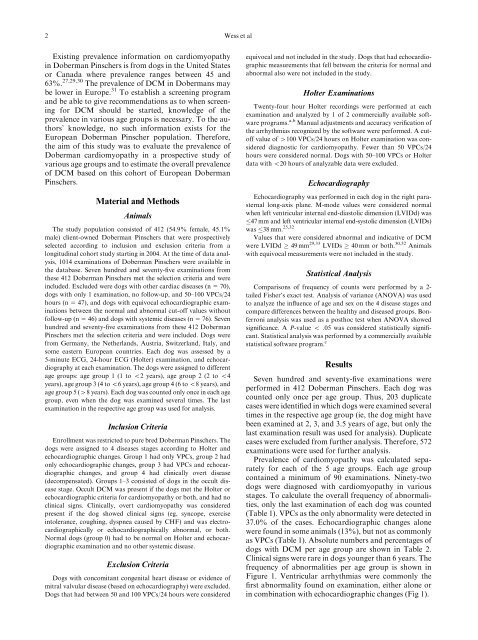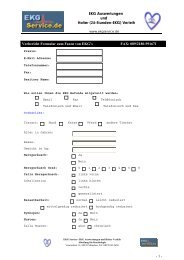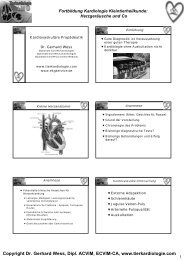Prevalence of Dilated Cardiomyopathy in Doberman Pinschers in ...
Prevalence of Dilated Cardiomyopathy in Doberman Pinschers in ...
Prevalence of Dilated Cardiomyopathy in Doberman Pinschers in ...
Create successful ePaper yourself
Turn your PDF publications into a flip-book with our unique Google optimized e-Paper software.
2 Wess et al<br />
Exist<strong>in</strong>g prevalence <strong>in</strong>formation on cardiomyopathy<br />
<strong>in</strong> <strong>Doberman</strong> P<strong>in</strong>schers is from dogs <strong>in</strong> the United States<br />
or Canada where prevalence ranges between 45 and<br />
63%. 27,29,30 The prevalence <strong>of</strong> DCM <strong>in</strong> <strong>Doberman</strong>s may<br />
be lower <strong>in</strong> Europe. 31 To establish a screen<strong>in</strong>g program<br />
and be able to give recommendations as to when screen<strong>in</strong>g<br />
for DCM should be started, knowledge <strong>of</strong> the<br />
prevalence <strong>in</strong> various age groups is necessary. To the authors’<br />
knowledge, no such <strong>in</strong>formation exists for the<br />
European <strong>Doberman</strong> P<strong>in</strong>scher population. Therefore,<br />
the aim <strong>of</strong> this study was to evaluate the prevalence <strong>of</strong><br />
<strong>Doberman</strong> cardiomyopathy <strong>in</strong> a prospective study <strong>of</strong><br />
various age groups and to estimate the overall prevalence<br />
<strong>of</strong> DCM based on this cohort <strong>of</strong> European <strong>Doberman</strong><br />
P<strong>in</strong>schers.<br />
Material and Methods<br />
Animals<br />
The study population consisted <strong>of</strong> 412 (54.9% female, 45.1%<br />
male) client-owned <strong>Doberman</strong> P<strong>in</strong>schers that were prospectively<br />
selected accord<strong>in</strong>g to <strong>in</strong>clusion and exclusion criteria from a<br />
longitud<strong>in</strong>al cohort study start<strong>in</strong>g <strong>in</strong> 2004. At the time <strong>of</strong> data analysis,<br />
1014 exam<strong>in</strong>ations <strong>of</strong> <strong>Doberman</strong> P<strong>in</strong>schers were available <strong>in</strong><br />
the database. Seven hundred and seventy-five exam<strong>in</strong>ations from<br />
these 412 <strong>Doberman</strong> P<strong>in</strong>schers met the selection criteria and were<br />
<strong>in</strong>cluded. Excluded were dogs with other cardiac diseases (n 5 70),<br />
dogs with only 1 exam<strong>in</strong>ation, no follow-up, and 50–100 VPCs/24<br />
hours (n 5 47), and dogs with equivocal echocardiographic exam<strong>in</strong>ations<br />
between the normal and abnormal cut-<strong>of</strong>f values without<br />
follow-up (n 5 46) and dogs with systemic diseases (n 5 76). Seven<br />
hundred and seventy-five exam<strong>in</strong>ations from these 412 <strong>Doberman</strong><br />
P<strong>in</strong>schers met the selection criteria and were <strong>in</strong>cluded. Dogs were<br />
from Germany, the Netherlands, Austria, Switzerland, Italy, and<br />
some eastern European countries. Each dog was assessed by a<br />
5-m<strong>in</strong>ute ECG, 24-hour ECG (Holter) exam<strong>in</strong>ation, and echocardiography<br />
at each exam<strong>in</strong>ation. The dogs were assigned to different<br />
age groups: age group 1 (1 to o2 years), age group 2 (2 to o4<br />
years), age group 3 (4 to o6 years), age group 4 (6 to o8 years), and<br />
age group 5 (48 years). Each dog was counted only once <strong>in</strong> each age<br />
group, even when the dog was exam<strong>in</strong>ed several times. The last<br />
exam<strong>in</strong>ation <strong>in</strong> the respective age group was used for analysis.<br />
Inclusion Criteria<br />
Enrollment was restricted to pure bred <strong>Doberman</strong> P<strong>in</strong>schers. The<br />
dogs were assigned to 4 diseases stages accord<strong>in</strong>g to Holter and<br />
echocardiographic changes. Group 1 had only VPCs, group 2 had<br />
only echocardiographic changes, group 3 had VPCs and echocardiographic<br />
changes, and group 4 had cl<strong>in</strong>ically overt disease<br />
(decompensated). Groups 1–3 consisted <strong>of</strong> dogs <strong>in</strong> the occult disease<br />
stage. Occult DCM was present if the dogs met the Holter or<br />
echocardiographic criteria for cardiomyopathy or both, and had no<br />
cl<strong>in</strong>ical signs. Cl<strong>in</strong>ically, overt cardiomyopathy was considered<br />
present if the dog showed cl<strong>in</strong>ical signs (eg, syncope, exercise<br />
<strong>in</strong>tolerance, cough<strong>in</strong>g, dyspnea caused by CHF) and was electrocardiographically<br />
or echocardiographically abnormal, or both.<br />
Normal dogs (group 0) had to be normal on Holter and echocardiographic<br />
exam<strong>in</strong>ation and no other systemic disease.<br />
Exclusion Criteria<br />
Dogs with concomitant congenital heart disease or evidence <strong>of</strong><br />
mitral valvular disease (based on echocardiography) were excluded.<br />
Dogs that had between 50 and 100 VPCs/24 hours were considered<br />
equivocal and not <strong>in</strong>cluded <strong>in</strong> the study. Dogs that had echocardiographic<br />
measurements that fell between the criteria for normal and<br />
abnormal also were not <strong>in</strong>cluded <strong>in</strong> the study.<br />
Holter Exam<strong>in</strong>ations<br />
Twenty-four hour Holter record<strong>in</strong>gs were performed at each<br />
exam<strong>in</strong>ation and analyzed by 1 <strong>of</strong> 2 commercially available s<strong>of</strong>tware<br />
programs. a,b Manual adjustments and accuracy verification <strong>of</strong><br />
the arrhythmias recognized by the s<strong>of</strong>tware were performed. A cut<strong>of</strong>f<br />
value <strong>of</strong> 4100 VPCs/24 hours on Holter exam<strong>in</strong>ation was considered<br />
diagnostic for cardiomyopathy. Fewer than 50 VPCs/24<br />
hours were considered normal. Dogs with 50–100 VPCs or Holter<br />
data with o20 hours <strong>of</strong> analyzable data were excluded.<br />
Echocardiography<br />
Echocardiography was performed <strong>in</strong> each dog <strong>in</strong> the right parasternal<br />
long-axis plane. M-mode values were considered normal<br />
when left ventricular <strong>in</strong>ternal end-diastolic dimension (LVIDd) was<br />
47 mm and left ventricular <strong>in</strong>ternal end-systolic dimension (LVIDs)<br />
was 38 mm. 25,32<br />
Values that were considered abnormal and <strong>in</strong>dicative <strong>of</strong> DCM<br />
were LVIDd 49 mm 29,33 LVIDs 40 mm or both. 30,32 Animals<br />
with equivocal measurements were not <strong>in</strong>cluded <strong>in</strong> the study.<br />
Statistical Analysis<br />
Comparisons <strong>of</strong> frequency <strong>of</strong> counts were performed by a 2-<br />
tailed Fisher’s exact test. Analysis <strong>of</strong> variance (ANOVA) was used<br />
to analyze the <strong>in</strong>fluence <strong>of</strong> age and sex on the 4 disease stages and<br />
compare differences between the healthy and diseased groups. Bonferroni<br />
analysis was used as a posthoc test when ANOVA showed<br />
significance. A P-value o .05 was considered statistically significant.<br />
Statistical analysis was performed by a commercially available<br />
statistical s<strong>of</strong>tware program. c Results<br />
Seven hundred and seventy-five exam<strong>in</strong>ations were<br />
performed <strong>in</strong> 412 <strong>Doberman</strong> P<strong>in</strong>schers. Each dog was<br />
counted only once per age group. Thus, 203 duplicate<br />
cases were identified <strong>in</strong> which dogs were exam<strong>in</strong>ed several<br />
times <strong>in</strong> the respective age group (ie, the dog might have<br />
been exam<strong>in</strong>ed at 2, 3, and 3.5 years <strong>of</strong> age, but only the<br />
last exam<strong>in</strong>ation result was used for analysis). Duplicate<br />
cases were excluded from further analysis. Therefore, 572<br />
exam<strong>in</strong>ations were used for further analysis.<br />
<strong>Prevalence</strong> <strong>of</strong> cardiomyopathy was calculated separately<br />
for each <strong>of</strong> the 5 age groups. Each age group<br />
conta<strong>in</strong>ed a m<strong>in</strong>imum <strong>of</strong> 90 exam<strong>in</strong>ations. N<strong>in</strong>ety-two<br />
dogs were diagnosed with cardiomyopathy <strong>in</strong> various<br />
stages. To calculate the overall frequency <strong>of</strong> abnormalities,<br />
only the last exam<strong>in</strong>ation <strong>of</strong> each dog was counted<br />
(Table 1). VPCs as the only abnormality were detected <strong>in</strong><br />
37.0% <strong>of</strong> the cases. Echocardiographic changes alone<br />
were found <strong>in</strong> some animals (13%), but not as commonly<br />
as VPCs (Table 1). Absolute numbers and percentages <strong>of</strong><br />
dogs with DCM per age group are shown <strong>in</strong> Table 2.<br />
Cl<strong>in</strong>ical signs were rare <strong>in</strong> dogs younger than 6 years. The<br />
frequency <strong>of</strong> abnormalities per age group is shown <strong>in</strong><br />
Figure 1. Ventricular arrhythmias were commonly the<br />
first abnormality found on exam<strong>in</strong>ation, either alone or<br />
<strong>in</strong> comb<strong>in</strong>ation with echocardiographic changes (Fig 1).






